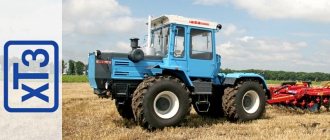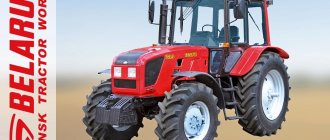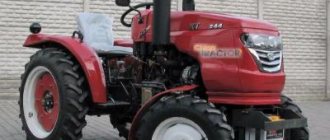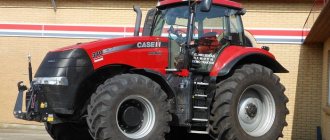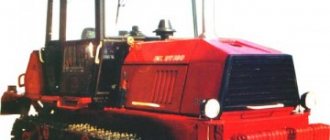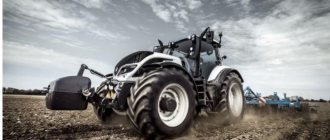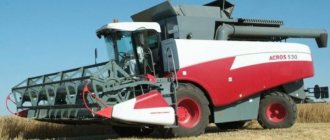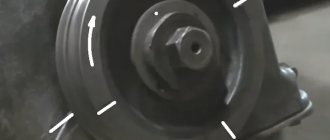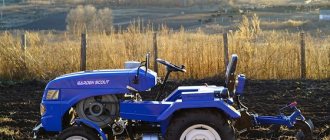The Kharkov plant is a leading manufacturer of wheeled and tracked tractors in Ukraine. During the Soviet era, the plant produced up to 70 thousand cars per year. The HTZ model range in 2022 includes wheeled vehicles based on the HTZ-150K, 242K and 243K models, tracked T-150 and HTZ-181, as well as the HTZ-3512 minitractor. The KhTZ-17221 and KhTZ 240K machines are being assembled in Russia. All KhTZ models are equipped with Russian and European diesel engines with a liquid cooling system.
All HTZ tractor models
KhTZ products include numerous models of tractors with a rated power of 35 - 190 hp. With.
The model range is represented by the following machines:
- Wheeled and crawler tractors for general use;
- Arable and row-crop equipment;
- Low-power equipment that is aggregated with various agricultural machines and equipment.
The Kharkov plant produces road construction and special equipment (based on tractors), various cutting tools, spare parts, and consumer goods.
The areas of application of technology are very diverse: agriculture, construction, utilities, industry, transportation of large cargo. Despite the wide range of work performed, it is worth paying attention to narrow-profile units, for example, a skidder.
Tractor HTZ 16131
A universal machine of the third traction class with great functionality.
Among the advantages of the tractor are good stability, modernized power traction and excellent cross-country ability. The HTZ 16131 tractor can be easily converted to reverse control. Parameters and features of the unit:
- Engine with a power of 180 hp. With.;
- Number of cylinders – six;
- Volume – 7140 cm3;
- Wheelbase – 2.8 m;
- Gearbox - manual;
- Ranges and forward speeds – 4 and 16;
- Reverse ranges and speeds – 2 and 8;
- The load capacity of the canopies is front-wheel drive 1500 kg, rear-wheel drive 1800 kg.
Tractor HTZ 17221
The equipment of this line is characterized by increased load capacity thanks to a two-cylinder device for coupling with canopies and trailers.
The tractor belongs to the third traction class. Specifications:
- Engine YaMZ-236D-3 with a power of 175 hp. With.;
- PTO - 2100 rpm;
- Number of cylinders – six;
- Fuel tank capacity – 430 liters;
- Fuel consumption - 251 g/kWh;
- Ranges and forward speeds – 3 and 12;
- Reverse ranges and speeds – 1 and 4;
- Maximum forward speed – 29.5 km/h;
- Maximum reverse speed – 9.1 km/h;
- Working width – 1860 mm;
- Load capacity – 4500 kgf.
The closed frame cabin is heated and ventilated, with two seats (the second is designed for one passenger).
The line was constantly modernized. Model KhTZ-17221-09 with a modified shape, in particular, it is a single-seat cabin. Other modifications are more serious. So models HTZ-17221-19 and HTZ-17221-2 with reinforced engines. The first has a six-cylinder diesel engine D-260, the second an eight-cylinder YaMZ-238.
Tractor HTZ-7
This machine became a real breakthrough after its release, as the first mini tractor in the USSR.
The design features of the tractor did not include a frame; pneumatic tires and a mounted hydraulic system were used for the first time. Technical parameters of the equipment:
- Engine with a power of 12 hp. With.;
- Torque - 1000 rpm;
- Gearbox – five forward and four rear;
- Travel speed – within 4.4 – 12.7 kilometers/hour;
- The weight of the unit is 1400 kilograms.
Tractor HTZ 2511
The model is in demand because it is economical, maneuverable and easy to maintain.
You can purchase various attachments to expand the capabilities of the tractor. Key technical parameters:
- Motor with a power of 27 horsepower;
- Fuel tank capacity – 50 liters;
- Maximum speed – 30 km/h;
- Turning radius – 3.5 meters;
- Dimensions – 142*328*249 cm;
- The mass of the unit is 2200 kilograms.
Tractor HTZ 3512
A mini tractor model that copes with various tasks.
It can be used for work in the garden, on land and even during construction. Advantages of the HTZ 3512 tractor:
- Reliable;
- Simple and easy to use;
- With a small turning radius of 3.5 meters;
- With a good soundproofed driver's cabin.
Technical parameters of the unit:
- Motor MMZ-3LD with a power of 35 hp. With.;
- Gearbox – manual with 8 forward and 6 reverse speeds;
- PTO with a rotation speed of 540 rpm;
- Fuel tank capacity – 50 liters;
- Traction strength – 0.8 kN;
- Wheelbase – 1837 mm;
- The weight of the unit is 2250 kilograms.
Tractor HTZ 181
The tracked model of the traction class is aggregated with a large number of canopies and trailers, so the tractor copes with labor-intensive and large-scale work.
Distinctive parameters of the machine:
- Increased traction;
- Economical consumption of resources;
- Compatible with various attachments that allow you to cultivate soil, care for crops, harvest crops, and transport cargo.
The dimensions of the powerful HTZ-181 unit correspond to the fifth traction class. The chassis has two rolling axles and side suspensions. Turns are made with the multi-disc clutch disengaged and the appropriate band brakes applied.
The importance of HT3-7 in the national economy
In the distant 195O/196O-s, the XT3-7 was used in the collective farm technology park together with more powerful wheeled tractors from the Minsk and Vladimir factories. Young machine operators trained on small XT3-7 to gain experience. Without being involved in full-scale field work, this small-displacement vehicle demonstrated good results in vegetable plantations and gardens, and in towing tractor trailers with feed, fertilizers, and building materials.
The appearance and mass production of high-quality small-sized row crop tractors of the 0.4 - 0.6 class traction class helped our country make a qualitative leap in the development of the country's fruit and vegetable industry. Soon, the shelves of Soviet stores began to be replenished with jars of juices, syrups, jams and pickles, and there were more wines on them. Kharkov small-sized tractors, the first of which was the XT3-7, made a huge contribution to increasing the volume of production of vegetables and fruits.
XT3-7 tractors were exported not only to socialist countries and the previously mentioned Mexico and India, but also beyond the “Iron Curtain” - to France, Holland, Finland. In terms of its manufacturability and design, the XT3-7 was at the level of the best world standards of that time.
Model range overview
HTZ 150
The Kharkov plant specializes in the production of wheeled tractors. The tracked model is represented by only 1 model - KhTZ 150 t.
It is equipped with a 150 hp diesel engine.
The tracked module allows you to move even on the heaviest and most viscous soils. To facilitate control, the HTZ 150 is equipped with power steering.
The operator's cabin in the crawler tractor has air conditioning and a fan to maintain a comfortable temperature during operation.
HTZ 150k
This is a wheeled tractor that belongs to the third traction class.
HTZ 240k
This is an improved model, which has greater traction capabilities than the HTZ 150k. Its maximum load capacity reaches 2 tons.
These characteristics are achieved due to the fact that the HTZ 240k tractor is equipped with a diesel engine with a capacity of 210 horsepower.
The weight of the device is 8370 kg. Overall dimensions of this model: 640 × 246 × 346 cm.
The maximum travel speed of the HTZ 240k tractor reaches 40 km/h.
HTZ 242k
The 240k model quickly gained popularity and was in demand among farmers for a long period of time. However, as time moves forward and technology develops, there is a need to modernize the 240k.
Therefore, the next model was released - the HTZ 242k wheeled tractor.
It is equipped with a diesel engine with a power of 240 horsepower. Thanks to this, the maximum load capacity has increased to 5 tons.
The HTZ 242k wheeled tractor has had an improved transmission (to withstand heavy loads) and a hydraulic system (to be able to perform work in compatibility with modern high-speed attachments).
The overall dimensions of this model are 6596x2460x3565 mm.
The HTZ 242k tractor is equipped with an additional seat and a ventilation and air conditioning system.
HTZ 243k
This is another upgrade of the 240k model. The HTZ 243k tractor is equipped with an engine with increased power up to 250 hp.
It is capable of working with denser soils and heavier attachments than 240k. The weight of 243k is 8450 kg.
HTZ 3512
This model is a mini tractor. It is equipped with a simple diesel engine with a power of 35 horsepower.
The fuel tank has a volume of 50 liters, with an average consumption of 5-7 l/h, this can ensure the autonomy of the device over a long period of time.
The drive in KhTZ 3512 is installed 4×2.
The weight of this wheeled tractor is 2128 kg.
HTZ 3522
This is a lightweight tractor that has a 35 hp diesel engine. HTZ 3522 can reach speeds of up to 30 km/h.
A dependent power take-off shaft is installed at the rear. The HTZ 3522 wheeled tractor has a 4×4 drive.
HTZ 5020
This is a lightweight model designed for use on prepared land. The power of the HTZ 5020 engine is 50 horsepower.
It runs on diesel.
The track size can be adjusted within 140-180 cm. This is convenient when hilling crops or other inter-row cultivation.
The weight of the model 5020 wheeled tractor is 2980 kg.
HTZ 17221
The HTZ 17221 wheeled tractor is equipped with a diesel engine. 180 horsepower.
The speed of movement on this machine can reach 50-60 km/h.
The mass of the unit is 8870 kg.
The HTZ 17221 tractor is equipped with a 4×4 drive. This model uses wheels with a larger diameter, which significantly reduces ground pressure and reduces fuel consumption by about 15%.
Advantages and disadvantages
HTZ tracked vehicles of the 181st model compare favorably with wheeled tractors:
- the most efficient traction characteristics;
- lower coefficient of specific ground pressure;
- absence of slipping on problem sections of roads without hard surfaces;
- relatively small turning radii.
These and other features of the use of caterpillar tractors make it possible to use all the advantages of wide-cut agricultural machines, master large volumes of work in a short time and with lower fuel and lubricant costs.
The above advantages of caterpillar tractors do not exclude significant disadvantages. This:
- lower speed range;
- the impossibility of moving tracked vehicles on public roads with hard, asphalt or concrete surfaces;
- Despite all the efforts of the designers, the working conditions for drivers of tracked tractors are less comfortable in relation to wheeled vehicles.
Video: demonstration of the 181st model
Maintenance
KhTZ tractors have gained great popularity due to their ease of maintenance and repair work.
Solutions to most problems are given in the operating instructions. Every tractor owner must have this document at hand.
The user manual contains basic information regarding: technical characteristics, safety measures, operating rules, procedures for working with various attachments, maintenance, rules for storing the tractor and how to correct basic faults.
- All tractors of this brand are professional and require appropriate engine maintenance.
- In winter, it is necessary to fill in M-8G2 or M-8G2k oils.
- In the summer, you can use less viscous brands: M-10G2 or M-10G2k.
- The lubricant should be changed after 1000 hours of operation of the tractor.
- Before changing the oil, it is necessary to warm up the engine to facilitate the release of lubricant from the system. The waste must be poured into a previously prepared container and disposed of in appropriate places.
- It is recommended to fill the transmission with TEP-15 oil. The lubricant in this unit should be replaced every 2000 operating hours.
- Diesel fuel must be used fresh and clean, it must comply with established standards. The use of old diesel engines is not allowed. It should not contain third-party mechanical impurities and sediment.
Device
T-012 received a manual gearbox. The driver of the vehicle had the opportunity to use 4 gears to move forward, 2 gears to move backward. The model received front and rear power take-off shafts with independent drive, which significantly increased its performance characteristics.
The mini-tractor had a dry single-plate clutch and no power steering. The T-012 was equipped with a drum-type brake mechanism.
The model did not have a cabin, but had an adjustable column. In addition, the driver's seat in the mini-tractor was distinguished by its softness, which made working on it convenient and comfortable. The seat offered excellent forward and rear visibility.
The T-012 had excellent performance, increased maneuverability and low maintenance requirements.
Repair
Every tractor owner should know the structure of this machine and how to correct the most common breakdowns. If the clutch “drives”, then this is what could cause it:
- The shutdown drive is not completely adjacent to the clutch (set the drive in the correct position);
- The gap between the parts has increased (it should be adjusted);
- The driven disk hub is stuck (the splines need to be cleaned);
- The driven disk has failed due to deformation (in this case, only a complete replacement of the spare part will help);
- Failure of the overhead disk (again, only replacement);
- Problems with the brake (incorrect clearance or wear).
- If shifting gears is difficult, it is necessary to adjust the length of the shift lock rod, the clutch brake or the release drive.
If the hydraulic system shows insufficient oil pressure:
- Lubricant level too low (add);
- The hydraulic drive filter is clogged (it should be cleaned);
- Oil pump faulty (replace the entire pump or faulty parts).
Adopting foreign experience
While the tractors of the USSR were “building up their muscles”, and Soviet designers were mastering a new direction for themselves, the government decided to launch production of foreign equipment under license. In 1923, the Kharkov plant put into production the tracked Kommunar, which was the successor to the German model Hanomag Z-50. They were primarily used by the military to transport artillery pieces until 1945 (and later).
In 1924, the Leningrad (future Kirov) mastered the production of a cheap and structurally simple “American”. Old USSR tractors of this brand have proven themselves quite well. They were head and shoulders superior in performance to both the Zaporozhets and Kolomenets. The carburetor kerosene engine (14.7 kW) developed a speed of up to 10.8 km/h, and the power at the hook was 6.6 kW. The gearbox is three-speed. The model was produced until 1932. In fact, this was the first large-scale production of this technology.
Owner reviews
Below are several opinions from thematic forums about the experience of operating HTZ tractors:
Alexander about HTZ 17221: “I’ve been working for the third season and, in principle, I’m satisfied. Pre-sowing tillage is carried out without problems. The same goes for sowing crops. The engine runs smoothly and smoothly, but there have been some breakdowns:
- In the first year, the teeth of the rear axle broke off (they were replaced under warranty at the service center).
- Then the hose on the hydraulic system became cracked and had to be replaced;
- The valve at the gearbox started to stick, so I had to repair it myself.
- The operator's cabin is large, but the noise is like in a train; not only is it coming from the engine, but the entire instrument panel is rattling.
There are no complaints about the work, but there are still complaints about the assembly."
"Russian" firstborn
Russia has always been famous for its inventors, but not all ideas could be put into practice. Back in the 18th century, agronomist I.M. Komov raised the topic of mechanization of agriculture. In the middle of the 19th century, V.P. Guryev and then D.A. Zagryazhsky developed steam tractors for plowing. In 1888, F.A. Blinov made and tested the first steam tractor on caterpillar tracks. However, the device turned out to be unnecessarily bulky. However, the official year of birth of the Russian tractor industry is considered to be 1896, when the world's first steam-powered caterpillar tractor was publicly demonstrated at the Nizhny Novgorod fair.
At the threshold of the 20th century, designer Ya. V. Mamin (a student of Blinov) invented a compressor-free high-compression engine running on heavy fuel. It was suited like no other for use in wheeled tracked vehicles. In 1911, he also assembled the first domestic tractor with an 18-kilowatt internal combustion engine, which received the patriotic name “Russian”. After modernization, a more powerful engine appeared on it - 33 kW. Their small-scale production was established at the Balakovo plant - until 1914, about a hundred units were produced.
In addition to Balakovo, piece tractors were produced in Bryansk, Kolomna, Rostov, Kharkov, Barvenkovo, Kichkass and a number of other settlements. But the total production of all tractors at domestic enterprises was so small that it had virtually no effect on the situation in agriculture. In 1913, the total number of this equipment is estimated at 165 copies. But foreign agricultural machinery was actively purchased: by 1917, 1,500 tractors were imported into the Russian Empire.
Tractor HTZ
Starting our review of KhTZ tractors, let’s devote a few words to the manufacturer. It is the Kharkov plant for the production of tractor machines, which established the production of agricultural machinery back in the early 30s of the last century. This is one of the largest machine-building enterprises in the current CIS, located in Ukraine.
Kharkov TZ produces a wide range of agricultural machinery, including:
- tracked vehicles;
- wheeled;
- special purpose equipment;
- road construction units.
Let's briefly consider all models of KhTZ tractors.
Features of coloring. Museum-historical rarity
Nowadays, more than sixty years after the release of the last XT3-7, there are very few tractors of this model left in the world in their original form - just a few. This is a historical rarity. Two copies are exhibited at the Tractor History Museum, which is located in the city of Cheboksary. One of them has the XT3 emblem on the hood, the other has the XTS3 emblem. Visitors to this museum often ask the question: why is one tractor painted green and the other red?
The answer is: during the years of mass production, the XT3-7 tractors, intended for delivery to domestic farms and for export to Europe, were painted with green paint. Those that were exported to India and Mexico were red. The green example, a tractor produced by XTS3 in 1952, was found in 2011 at a personal farmstead in the Tula region. Its engine was jammed, its wings were completely rotten, and many parts were missing. According to old drawings, XT3-7 was restored, is on the move and often participates in various events - such as the annual displays of rarities on the “Night of Museums”. A red tractor is installed in the main hall of the museum, joining the row of other Soviet all-purpose cultivators.
Model range overview
The plant produces many wheeled and tracked models, let's look at the existing options:
- HTZ-7
- HTZ T-012
- HTZ-DT20
- HTZ-T25
- HTZ-T74
- XT-121
- HTZ T-150
- HTZ-T150K
- HTZ-181
- HTZ-240K
- HTZ-242K
- HTZ-243
- HTZ-243K
- HTZ-1721
- HTZ-2511
- HTZ-3512
- HTZ-5020
- HTZ-3522
- HTZ-16131
- HTZ-17221
- SHTZ-NATI
We invite you to familiarize yourself with the characteristics of the presented modifications of tractor machines from the Kharkov plant.
The first compact frameless tractor of the USSR, on which pneumatic wheels and a mounted hydraulic system were installed for the first time.
Its weight was only 1400 kg, the performance of the power plant was 12 hp. The car was equipped with a two-satellite differential.
Characteristics
HTZ T-012
A reliable, safe tractor that is easy to operate and safe. Its performance is 11 hp, while the fuel tank capacity is 21 liters.
HTZ DT-20
The tractor power was 18 hp. It was distinguished by high performance characteristics. Its serial production was suspended in 1969.
HTZ T-25
Serial production of this model lasted about 5 years. The machine has gained great popularity due to its excellent maneuverability, ease of use, and reliability of all components. A special feature of this model were pneumatic wheels - the wheels installed at the rear had a larger diameter, and those at the front had a smaller diameter.
Engine performance was 25 hp. The front axle is balanced. Fast braking was provided by band-type brakes. A rigid suspension is installed.
HTZ T-74
A very successful modification, it was distinguished by increased reliability and versatility, rarely failed, and was produced in 5 variations. Out of production in 1984.
The tractor was actively used both for various agricultural work and for a wide range of road, construction and transport work.
HTZ-121
A very successful design, characterized by increased maneuverability, reliability of all components and mechanisms, and high maneuverability. The machine was able to overcome any obstacles, had high wear resistance, maintainability and high performance indicators.
In addition, it has very simple controls. The unit was equipped with an SND-23 engine with an electric starter with a capacity of 145 hp. With. The car could reach speeds of more than 30 km/h.
HTZ T-150K
This model belongs to the 3rd traction class. Her weight is 8200 kg. A diesel power plant with a capacity of 128.7 hp is installed.
The cabin is perfectly sealed, with built-in heating and ventilation systems that increase operator comfort at any time of the year.
HTZ T-150
The tracked modification is characterized by high maneuverability on various types of soil. The tractor is equipped with a diesel power unit with a capacity of 150 liters. With.
To make it easier to control the machine, the manufacturer provides power steering. An excellent, comfortable cabin will protect the operator from the summer heat and winter cold, outside noise and dampness. The built-in air conditioner further increases comfort inside the cabin.
Characteristics
HTZ-181
This tracked model has increased maneuverability, stability, and can be used both on flat and sloping areas. The universal unit is capable of performing various agricultural, skidding, construction, municipal and road works, is highly reliable, and the build quality is excellent.
The tractor's torsion-spring suspension is specially extended and has five rollers, which reduces pressure on the soil and allows for the necessary smoothness of movement even in rough terrain. The tractor is equipped with a diesel engine with a capacity of 190 hp.
Characteristics
HTZ-240K
Tractor weight 8370 kg. The vehicle is equipped with a 6-cylinder Common Rail power unit with a capacity of 210 hp. There are three modifications of the 240K tractor, differing in diesel brands.
The load capacity of the unit is 2 tons. The modernized gearbox ensures a smooth transition from one speed to another, the speed range is impressive. The wheels are enlarged and adapted for smooth and confident off-road driving.
HTZ-242K
The tractor is equipped with a 240 hp power plant. The carrying capacity has increased - now the machine can pull up to 5 tons of cargo.
The manufacturer improved the tractor transmission and installed an additional seat for the operator in the cab, equipped not only with a stove and fan, but also with an air conditioning system. The hydraulic system has also undergone modernization, allowing the operation of high-speed mounted units.
HTZ-243
The tractor weighs about 8.6 tons. The performance of the diesel unit is 250 hp. The load capacity of the rear linkage is about 6 tons. The gearbox has been improved, ensuring a smooth transition of speeds.
The tractor is equipped with an ergonomic frame cab, a comfortable driver's seat, and an air conditioning and heating system. The steering column has a lever shift.
Characteristics
HTZ-243K
The tractor weighs 8450 kg. The diesel engine produces 250 hp. The unit is used for all types of agricultural work in areas with heavy soils.
About the history of the Kharkov Tractor Plant
The peak of development of the Kharkov Tractor Plant occurred precisely at the beginning of the notorious “perestroika”. In the mid-80s of the twentieth century, KhTZ produced 70 thousand tractors a year and supplied them to 36 countries. The KhTZ training workshop, operating since 1961, was known throughout the country, where good conditions were created for innovators and experimenters and work was constantly carried out to improve tractors of the popular T-150 family.
The total number of tractors produced by the plant since 1931 reached 2.5 million units in the 80s. In addition, workshops producing armored vehicles for the needs of the Ministry of Defense were working steadily: self-propelled artillery mounts, armored personnel carriers and army tractors.
Now, of course, there can be no talk of such production volumes. Throughout the 90s/2000s, it passed from one owner to another, several times stopping production altogether for 3-10 months. The production of armored vehicles was completely stopped in 2008. The best year for KhTZ in recent history was 2005, when the company produced 2,500 tractors.
However, over the years, a number of attempts have been made to introduce into mass production new models of tractors of different traction classes - from the small tractor for small farms "KhTZ-2410" (with a Chinese diesel engine 25 hp), to the first Kharkov industrial and road construction bulldozer "TS-10" (in collaboration with the Bosch concern); Work continued on modernizing models based on the classic T-150. One of such quite successful projects of the enterprise was “KhTZ-181”.
User manual
Diesel engines, which are installed on all tractors marked HTZ, are distinguished by their unpretentiousness both in maintenance and operation. Despite this, care should still be taken to extend the service life of the unit.
Maintenance
Maintenance consists of simple steps:
- Run in the power plant immediately after purchasing the tractor. The procedure lasts about 8 hours, begins without stress and gradually increases it.
- Replace engine and transmission oils in a timely manner in accordance with the time of year and the number of engine hours worked. In summer, the following motor oils are recommended: M-10G2 and M-10G2k.
- In winter, it is recommended to use the following brands of motor oils: M-8G2 and M-8G2k.
- Transmission oil - TEP-15.
- When preserving a diesel tractor, it is necessary to drain all working fluids and thoroughly clean and lubricate the unit.
Basic malfunctions and ways to eliminate them
The operating instructions for the HTZ tractor contain a complete list of possible malfunctions characteristic of machines from the Kharkov plant. Let us describe the reasons that affect the startup of a diesel power plant:
- The fuel does not meet the declared quality.
- The tank has run out of diesel fuel.
- The oil is running out or is of poor quality.
- The filtration system is clogged; the fuel and air filters require cleaning or replacement.
- The high pressure fuel pump (HPFP) has failed or is clogged.
Engine
The minitractor received an air-cooled SK-12 carburetor engine with two cylinders. This unit was produced in Kazakhstan. The power of the T-012 power plant at maximum speed was 11 “horses”. The manufacturer guaranteed reliable operation of the motor for 6,000 operating hours. After this, the engine was overhauled.
The SK-12 small-displacement unit used in the Kharkov mini-tractor was equipped with an automatic regulator that controls and ensures the number of crankshaft revolutions within a given limit in the event of a load change to nominal values.
In some cases, shielding was installed on parts of the ignition system to eliminate radio interference. The SK-12 was additionally equipped with various elements at the request of the customer. The air entering the carburetor of the T-012 power plant was accelerated to the required speed in the nozzle. A vacuum was created in the narrow section, allowing fuel to enter the nozzle and atomizer, and then into the air flow. Fuel atomization and evaporation occurred. The mixture entered the engine intake valve through a pipe, and the power was regulated by the throttle valve.
Air cooling was used to lower the temperature of the cylinder walls. It prevented the grease on the walls from burning. Special filters were used to clean the T-012, and a regulator was used to control it. The SK-12 engine was started using an electric starter. The mini-tractor developed a forward speed of up to 15 km/h, and a backward speed of up to 4 km/h.
Owner reviews
Vladimir, 53 years old:
“I work as a machine operator on a farm; I worked for a long time at KhTZ 240. The tractor has a powerful eight-cylinder Yamz-238 engine. The car is strong and durable. Can be repaired and performs many operations.”
Nikolay, 41 years old:
“Hello, I have been working with KhTZ tractors for more than 17 years, in particular with the T 150k and T-150. For the wheeled T 150k I can say unequivocally - it’s an excellent tractor, the gearbox and engine are perfectly matched, the machine rarely breaks down, it’s very durable and functional, the hydraulics cope with all the tasks. But the T-150 tracked tractor is the exact opposite of the wheeled one: the weak gearbox lasts for 1.5-2 years, the tracks cannot withstand the loads, the track breaks within a year, and the tractor itself often breaks down. As for comfort in the cabin, it is there, but I would like to achieve even greater tightness and sound insulation.”
Yuri, 45 years old:
“I started my career at KhTZ 242k and spent many hours repairing this tractor. The hydraulics are rather weak: there is only one pump for both the hydraulics and the steering wheel - the pump simply cannot withstand the load, it lasts for a year. I can’t say anything bad about functionality - all agricultural work, any attachments, equipment, the machine pulls everything.”
Attachments
KhTZ tractors can work with universal mounted equipment of Russian and foreign production, these are:
- plow with several shares;
- agricultural equipment for sowing, care and harvesting;
- trailer with a carrying capacity of 15-20 tons.
The HTZ tractor model 17221 is equipped from the factory with a bulldozer blade with adjustable position in the vertical plane. The angle of attack has 2 fixed positions, which can be adjusted manually. The bulldozer blade can be installed from the factory on other models.
DT-54
Crawler tractors of the USSR became widespread in the mid-20th century; they outnumbered wheeled ones in the number of models. An excellent example of general-purpose agricultural machinery is the DT-54 tractor, produced in 1949-1979. It was produced at the Stalingrad, Kharkov and Altai factories with a total number of 957,900 units. He “starred” in many films (“Ivan Brovkin in the Virgin Lands”, “It Was in Penkovo”, “Kalina Krasnaya” and others), and was installed as a monument in dozens of settlements.
The D-54 engine is in-line, four-cylinder, four-stroke, liquid-cooled, rigidly mounted on the frame. Engine speed (power) is 1300 rpm (54 hp). The five-speed three-way gearbox and main clutch are connected by a cardan drive. Operating speed: 3.59-7.9 km/h, traction force: 1000-2850 kg.
